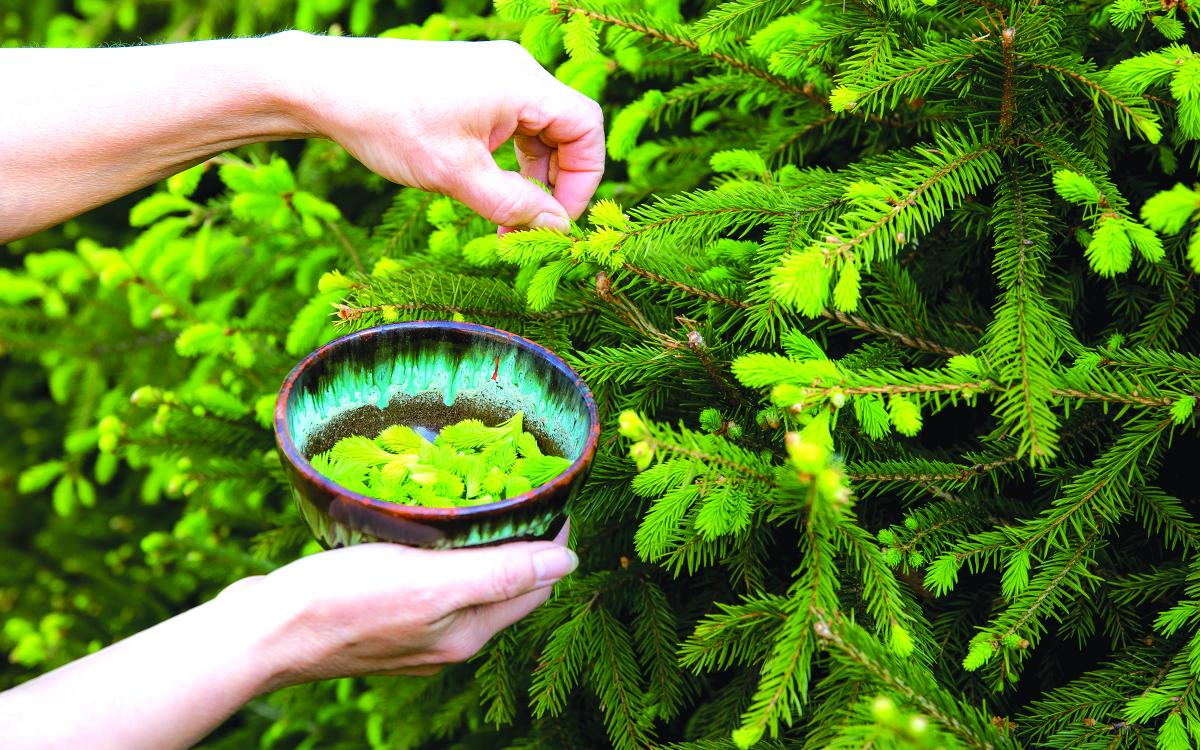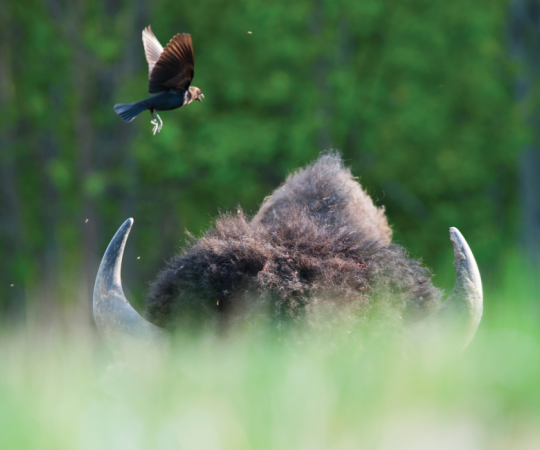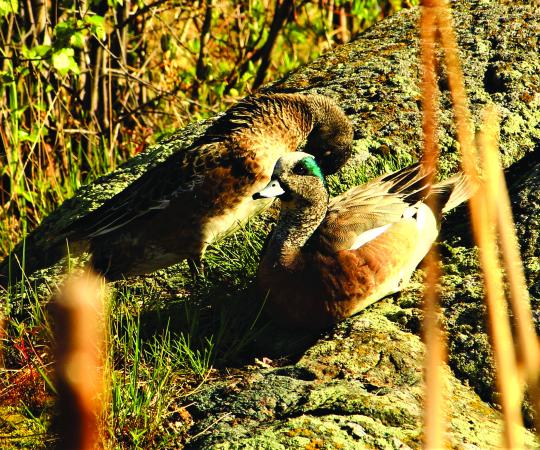Each traditional group (from Dene, Cree, and Chipewyan, and Gwich’in to Iñupiat, Inuvialuit, Inuit and related groups) developed specific ways of using plants, some quite specific to the particular Indigenous group. As outsiders moved into the North, they brought with them their own traditions of using plants. And, as more and more introduced plants move into the North, there are ways of using these plants as well.
As springtime comes to the North, we are drawn out onto the land, to hike the forest trails, and admire the greening marshes and emerging wildflowers, and reaching out to caress tender green foliage, and yes, to taste it as well!
In this two-part article, we’ll look first at the plants used in spring and early summer and then those used later in the year.
We’ll not cover the use of plants for medicine. It is complicated, can be dangerous, and always should be presented by a healer from the particular culture using the plants.
SAP
As the days lengthen and spring comes, with nights below and days above freezing, sap begins to rise in woody plants. This first sap contains sugars stored in the roots of trees during the winter, and makes the best syrup.
The sap of paper birch (Betula papyrifera) is often tapped and boiled down to produce a tasty syrup. Lighter in colour and taste than maple syrup, it takes 100 gallons of birch sap to make a gallon of syrup (in comparison, it takes 40 gallons of maple sap to make one gallon of syrup). Unprocessed sap can be used to make “birch water”, or brewed into coffee or tea and lends a smoothness and slight sweetness to the beverage. Birch syrup is also used in making birch beer. Commercial producers like Arctic Harvest (Yellowknife) and Uncle Berwyn’s Yukon Birch Syrup (Dawson City) offer online sales of syrup, and often tours of their operations.

LEAVES
The fresh young leaves of many plants are edible and more easily digested than more mature parts.
The new shoots and leaves of the tall fireweed (Chamerion angustifolium) are easily recognizable and often emerge where there is little other early foliage. They are slender and dark purplish red and can be picked and eaten raw or boiled or steamed and eaten. The smaller dwarf fireweed (Chamerion latifolium) is common in all the northern territories. In both species, leaves, stems and flowers are edible.
Dandelion is found in temperate regions throughout the world and is cultivated as a food plant in northern Europe. Dandelions common in southern NWT communities are mostly the introduced Taraxacum officinale. Young leaves are tender and tasty, but become bitter as they age, so collect early. New leaves can be eaten raw in salads or steamed or boiled and offer high levels of calcium and phosphorus, plus extremely high levels of Vitamin A, C, and D. Roots are edible, but are better when the leaves are just emerging as most of the nutrients are still in the roots at that time of year. Use a spade to dig these, as the useful parts extend 10 to 12 inches into the ground. Peel off the dark outside coating to expose the edible portion. Roots can be boiled, steamed or eaten raw.
Spruce tips are the new spring growth of either white (Picea glauca) or black spruce (Picea mariana). Collect these while they are still light green and soft, usually just after most snow melts. Take the side tips rather than the end, as the branch can’t grow that year if the end tip is removed. Spruce tips can be eaten as is, added to drinking water, chopped and sprinkled into soups, pastas, or combined with olive oil, pine nuts and basil to make a pesto. Spruce tips can be steeped to make a light tea or brewed into beer. (Beer making is beyond the scope of this article but there are many recipes available online!).
Several of the berry-producing plants also have leaves that are used in brewing teas. This includes the raspberries (Rubus strigosus, Rubus acaulis), blueberries (Vaccinium uliginosum), and strawberries (Fragaria virginiana).

Mountain sorrel (Oxyria digyna) has juicy leaves that taste a bit like rhubarb. Though they contain some oxalic acid, these are not toxic, unlike rhubarb leaves. Inuit have used these for centuries while hunting or travelling, picking the leaves as they walk. Large leaves can be added to boiling wild meat, and reduce into a delicious gravy. Fresh leaves can also be steeped and cooled to make a refreshing lemonade-like beverage.
Another very common plant with edible leaves is the introduced lamb’s quarter (Chenopodium album), common in most of the southern communities of the NWT and Yukon. It grows in gardens and places with disturbed soil. The new growth of this plant can be eaten raw as salad greens or cooked much like spinach and is great eating. When handfuls of this plant are dropped into boiling water, it turns bright green as it cooks, and reduces greatly in size. Only brief cooking is needed. Add butter and a bit of seasoning and you have a delectable dish high in calcium, iron and Vitamins A, B, and C.
Wild chives (Allium schoenoprasum) are common throughout the subarctic, along riverbanks and lakeshores, sometimes on rocky slopes with small seeps. These are similar to green onions but much smaller, with reddish pink flowers in June and July, and are usable all summer. The leaves are cylindrical and when crushed smell like onions. The clustered bulbs are small and look like green onions. Use raw or any way you would use onions or chives.
Some leafy plants should be used with caution, however. The narrow leaves and small clusters of white flowers of Labrador tea (Ledum sp.) are widely used as a tea. However, they should be steeped only briefly; better used as a flavouring for tea rather than the main ingredient. Labrador tea contains a chemical called ledol, which may slow the heart rate and should be used with extreme care.
In some wild greens, both the foliage and stems can be used. In summer, my yard in Yellowknife is covered with a tangled carpet of chickweed (Stellaria media). This light green plant has opposite leaves and small white five-petaled flowers; each petal is split down the middle and looks like two petals. The early growth can easily be collected and boiled briefly to make a cooked green dish similar to spinach. The stems, leaves and flowers all can be used. Avoid late summer growth as the stems can be tough.
BUDS AND FLOWERS
The low growing pineapple weed (Matricaria matricarioides) is found in parking lots, edges of roads, along skidoo trails. It is introduced, and has spread widely in North America. When crushed, the foliage smells like pineapple. Buds, young stems and young leaves can be eaten or steeped into a light and refreshing tea. Another common species, especially in the tideline along the arctic and Hudson Bay coasts, is sea-shore chamomile (Matricaria ambigua). It often forms lush growths, and the young leaves and flower buds are used for tea.
The flowers of both fireweeds (tall and dwarf) can be eaten, used to decorate cakes, or made into a delicate syrup. Allow the flowers to sit for an hour and then shake to remove any tiny insects inhabiting the flowers. The flowers of the purple mountain saxifrage (Saxifraga oppositifolia) have for generations been eaten by Inuit as candy, and the flowers of several species of lousewort (Pedicularis sp.) are also eaten for their minute amounts of nectar.
Although all parts of the violet (Viola sp.) are edible, the flowers are most in demand for salads and as decorations on cakes and pastries. Shake the flowers to remove insects before using. The foliage can be eaten raw in a salad or briefly cooked as a potherb. Pick only where these are abundant.
Wild roses (mostly Rosa acicularis) are common in the subarctic, often draping fences and roadside bushes and producing showy flowers. The flowers and petals of the wild rose are edible. The buds are often added to salads, or the petals are used later in the season. If using buds, remove the sepals around the base of the flower as these are tough and bitter. Young shoots and leaves are also edible. Pick early before the thorns harden.

BARK
The bark of willow trees (Salix sp.) was, and occasionally still is, used in the North as a springtime delicacy. Finger-sized branches are harvested in early spring, the outer layer of bark is removed, and the light-coloured cambium layer is scraped off and eaten.
If the sap is rising in the willows, this layer is sweet. In the past, it was sought by elders who were experiencing rheumatism or arthritic pain, and found it helped relieve pain.
A couple “cautions”: Just because you see an animal or bird eating a plant does mean it is safe for a human to do so. Also, if you are on prescription medications, be careful about consuming wild plants, as these may interfere with the action of
the medication.
GOING FORAGING?
First of all, make sure the area you are visiting is open to foraging.
If the area is owned by a particular Indigenous group or an individual, you MUST ask for permission before entering or collecting. Rules vary for local, territorial and national parks; check before you go.
Second, make sure you have adequate references to be sure you are not misidentifying plants.
Dress for the season, conditions, and terrain you are visiting. For most foraging, you will need good waterproof footwear.
Let someone know where you are going (use a map) and when you expect to be back. Take communications equipment: a fully charged cell phone, personal locator beacon (often available for loan from the local hunters and trappers organization), or satellite phone if you are going into an area with spotty cell phone service (and this includes much of the Ingraham Trail). And, a first aid kit (including Bendryl, in case you encounter something to which you are allergic).
Bring water to drink, something to eat, insect repellent, sun protection, a knife or multi-tool, and matches. Bring rain gear if conditions warrant and a roll of toilet paper. And, a daypack to carry it all.
Bring proper containers for your collections. Plastic bags are ok for foliage, but berries should be collected into rigid containers or baskets so they are not crushed. Process everything soon as you get home.
If there are few plants of the species you want, DO NOT COLLECT. Take care where you walk – you may be collecting a few of something common but make sure you are not trampling rare plants to do so.
Don’t collect on golf courses, close to roadsides, or in lawns. Pesticides may have been used, making the local plants toxic. Avoid polluted water bodies, of course.
Follow the words of the Elders. Be thankful to the plants for what you are collecting. Elders often leave offerings, especially when collecting plants for medicinal uses. Grateful thanks and an appreciation of the gifts of the plants shows compassion for the natural world.









